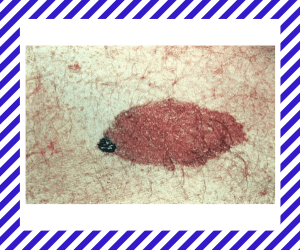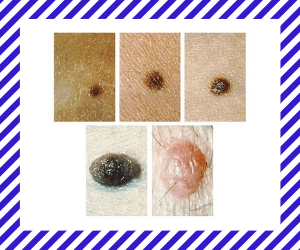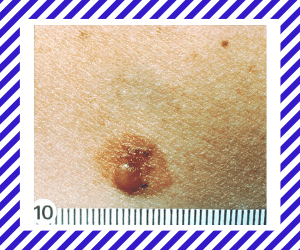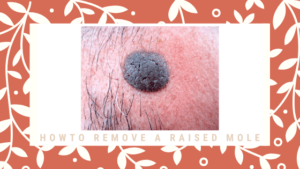Skin moles are common, but what is a mole, and how much do we know about them?
With various shapes, sizes, and even colors, it’s hard to know if they’re the dangerous type and how to remove them.
An expert in oncology at UnityPoint Health, Gina Mandernach offered a simple explanation of what moles are. Skin cells known as melanocytes are responsible for giving skin its natural color. This is why some people have lighter or darker skin tones naturally. The melanocytes are typically distributed throughout the skin to provide an even tone. However, when they grow in a cluster, they form a dark area that we call a mole.
Contents
Types Of Moles
Congenital Moles

AKA Congenital melanocytic nevus These are moles that you’re born with and usually stay the same over time.
Common Moles

Also known as an acquired mole. This usually refers to moles that appear on the skin after birth. Most people have about 10-40 at any one time. However, having more than 50 may increase the risk of skin cancer.
Atypical Moles

This may also be referred to as a dysplastic nevus. An atypical mole may have an odd shape, be larger than a pencil eraser, and have multiple colors.
What causes moles?
Although many of us have moles, their causes are not well-understood. A new mole that appears may be harmless or cancerous. The causes of skin cancer have been studied, but there isn’t much research on what causes a harmless mole.
Genetic mutations are likely at least somewhat responsible. A 2015 study found that mutations in the BRAF gene were present, with 78% of moles that appeared after birth. BRAF mutations can also be involved with melanoma. However, the transformation of a harmless mole to a cancerous one is not well known.
Ultraviolet light also interacts with DNA and can cause genetic damage that leads to new mole formation. Some people may notice that they also have new moles or freckles appear on their skin after they get a tan.
Other reasons that you could develop a new mole may include the following:
- Increasing age
- Fair skin with light hair
- Family history of moles
- Drugs that suppress the immune system
- Response to drugs such as hormones, antibiotics, or antidepressants
- Genetic mutations
- Sunburn or tanning bed use
Anyone who develops moles should be aware of the potential inherent risk of transforming into a cancerous mole. A 2017 review of cases found that approximately 71% of melanoma originated with a new mole development. Anyone who develops moles, especially ones that appear to be concerning, should visit a dermatologist for expert advice.
Evaluating a Mole
Although your best option is to see a dermatologist if you have any concerns, you can monitor your moles as well. A benign mole should stay the same over time. This means that it should not grow or change color or shape. If you notice your moles changing over time, you should seek out an expert.
Moles that are concerning have certain characteristics. They are asymmetrical and may have irregular borders. The mole may have changed color or is more than one color. A mole that is growing or changing over time is also concerning. This does not mean that the mole is cancerous, but it is a cause for concern.
Mole Removal
If a mole is either undesirable or possibly malignant, you may want to have it removed or checked by a dermatologist at the very least. If concerns for melanoma, it’s best to have your doctor remove it. However, there are also options for at-home removal for relatively safe moles.
When a doctor removes a mole, your doctor will numb the area and then cut it out. They may bandage the area as well. The mole will be sent to a lab for testing if its appearance has a reason for concern.
For moles that are small and not considered dangerous, your doctor will actually shave them off. This also involves numbing the area and then using a surgical blade to shave off the raised portion. This does not require any stitches, and the area should heal in a week or two. However, this method only works with raised moles.
At-home mole removal
There are several removal methods you can perform at home. Some are more effective than others depending on the type and size of the mole. These are a few methods to try:
Tea tree oil
This essential oil may help to get rid of small moles. Use it when diluted and apply to the mole several times a day.
Mole Removal tools
There are Home removal tools and kits available which are affordable, effective, and safe. The Tommy Timmy Spot Blaster Pro is a popular, safe, and effective option that is very effective for removing moles and other skin applications.
Hydrogen peroxide
Used for years as a whitening tool, this won’t remove the mole but may bleach it effectively. Talk to a pharmacist to get the right type.
Banana peels
Some people frequently use the peel for its whitening effects. Rub the peel on the skin daily. This also moisturizes the skin as a bonus.
Do moles grow back?
This is a frequent question and a common concern that many people have. After all, why remove a mole if it’s going to come back? Moles that a doctor completely removes will not come back, although shaved moles can come back. With home remedies, individual results can vary. Unfortunately, there’s no way to predict whether this will happen or not. Additionally, if a mole has hairs, the hairs will often grow back even if the mole itself doesn’t.
The good news for anyone who has a mole removed is that removing it does not make it grow back larger. It’s also unlikely to develop into skin cancer. Having moles removed doesn’t prevent them from occurring in the future. Following skin protection guidelines and self-monitoring are the best ways to prevent future moles or problems. Keeping up with good skincare is highly recommended to avoid problems as well.










